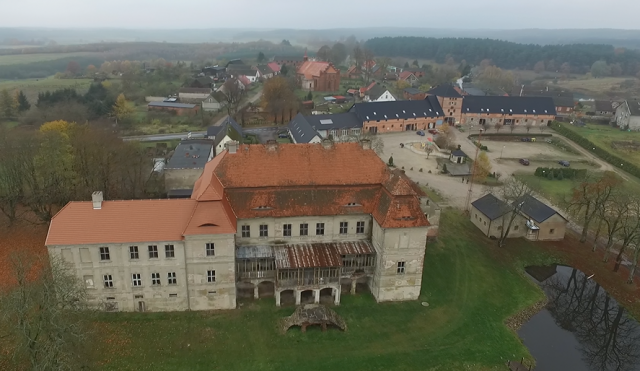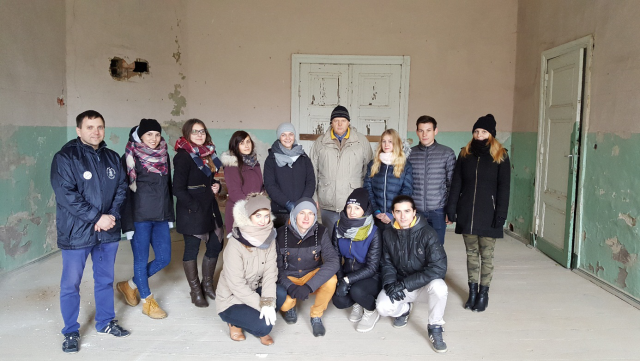In the period 4-6 November 2016, members of our "Metitri" Scientific Association together with their supervisor, Grzegorz Stępień, PhD, had the pleasure of visiting the historical Palace in Siemczyno (Drawskie Lake District) to conduct measurements thanks to the invitation from Mr Bogdan Andziak - the owner of the facility and Vice-President of the Henry's Association in Siemczyno.

The Palace in Siemczyno is a 290-year-old Baroque building with the surrounding park and leisure complex, which used to be the seat of von Goltz family. Bringing the history of the facility closer to us resulted in our finding out about many interesting facts concerning the area and the palace itself, which, as it turned out, in spite of later extensions and rebuilding, retained its original shape and division into rooms.
On the first day, in spite of the late arrival of our group in Siemczyno, right after getting accommodated, we received a warm welcome from the Vice-President of the Association and had an opportunity to get initially acquainted with the complex before performing our work.
The second day began with sightseeing of the palace and bringing its history closer to us by Mr Bogdan Andziak who shared with us his extensive knowledge on the subject, while we were listening to his stories with huge interest. We paid special attention to the cellars, which were built earlier than the palace and used to be a separate residential complex.
Having finished our sightseeing, we began to get ready for measurements with a FARO laser scanner beginning from the attic with about 10-minute sessions in each position. Our group consisted of students from three different years of studies so, before getting to work, Mr Grzegorz Stępień made us acquainted with the manner of operation, the functions and control of the scanner so that each of us would be able to perform subsequent scans. Meanwhile, we divided into three teams to accelerate the work on creation of the palace model: the first one was working with the scanner, the second one was processing the scans with the use of FARO SCENE software, while the third one, taking advantage of a temporary improvement of weather, went outside to perform drone flights above the palace.
Work in the attic took us the most time due to a significant number of positions and the working time of the scanner. The photos during the drone flight were taken with the use of Unmanned Aircraft System DJI Phantom 3 Professional with preparation of a double network with 90% coverage with a slanted camera and 80% coverage with the camera in a vertical position. Due to unfavourable weather conditions we had to make a break and postpone further work with the unmanned aircraft system until the following day.
Following a lunch break, we decided to process the prepared scans in the FARO SCENE software so that everyone could get acquainted with the programme and the methodology of work. Having finished creation of a cloud of points, we presented the results to the owner of the Palace, Mr Bogdan Andziak, and discussed further stages of our work on creation of the palace model. We decided to devote the rest of the evening to integration of our association as well as a night tour of the palace.
On the third day, right after breakfast, we went outside, taking advantage of better weather, to make a film presenting the palace surrounding and next to perform a flight above the whole area (ca. 12 ha) with the camera in a vertical position, simultaneously beginning further work with the scanner, this time inside the palace rooms located on the ground floor. After lunch break, we divided into two teams, one of which continued scanning of the rooms, whereas the other one, together with our supervisor, performed a flight above the palace taking photos of the façade necessary for further work on the model. Thanks to this, members of our association, had an opportunity to try their hand at piloting the UAS, simultaneously taking an active part in carrying out of this stage of the project.
This was the first trip of our association to the Palace in Siemczyno and definitely not the last one. Except for several days of field work, the only thing left is development of measurement results, which will surely extend our knowledge and enable us to prepare the model of the palace. Further work will be done in several programmes, i.e. PIX4D for preparation of the photos taken during flights, FARO SCENE for processing of further scans and Revit for combination of both models of the Palace in Siemczyno.
Summing up the trip of our association to Siemczyno, it is possible to talk about a new, fruitful experience for all of us, thanks to which we were able to extend our previous knowledge as well as learn so many new things related to using the equipment at work as well as the software necessary for processing of the results. The trip enabled us to get closer, which made our group even stronger. Another positive aspect is that we were able to extend our interests. There is a lot of work to be done, but each stage ahead of us will definitely allow us to strengthen our knowledge gained during the studies.
Marta Machowska - “Metiri” Scientific Association
Acknowledgements
The “Metiri” Scientific Association would like to express sincere thanks to Mr Bogdan Andziak for receiving us in the Palace and Farm Complex in Siemczyno as well as for the opportunity to visit the Palace, learn about its history and perform measurements.











